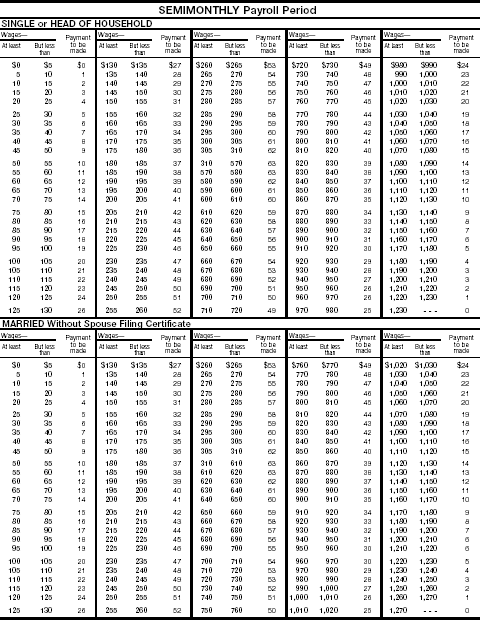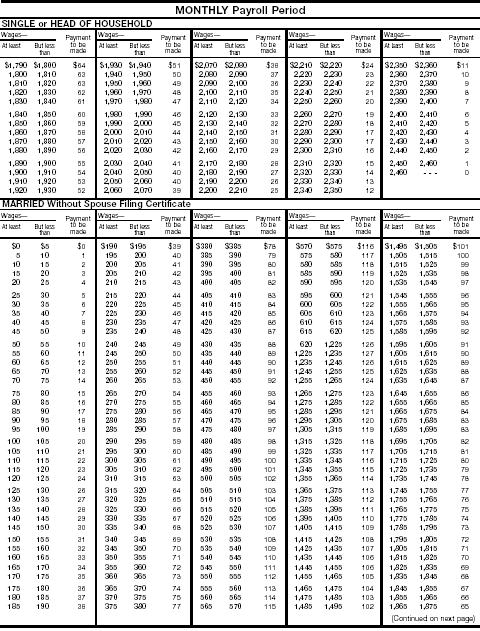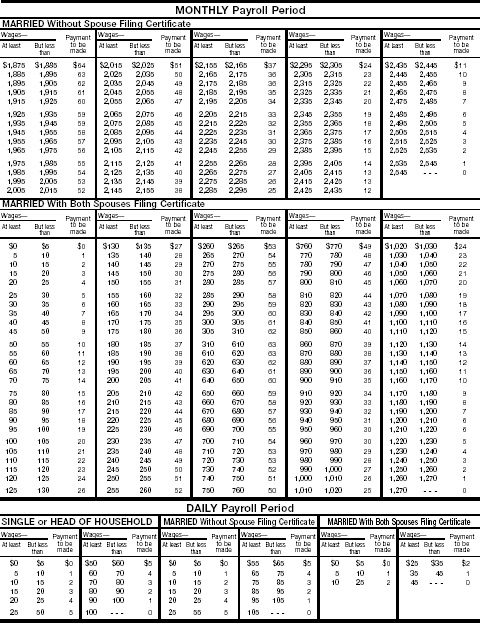11. Records You Should Keep
Every employer subject to employment taxes must keep all related records available for inspection for at least 4 years after the due date for the return period to which the records relate, or the date the taxes are paid, whichever is later. You may keep the records in whatever form you choose.
Keep a record of:
- Your EIN.
- Names, addresses, social security numbers, and occupations of employees.
- Dates of employees' employment.
- Amounts and dates of all cash wages, annuity, and pension payments.
- Fair market value and dates of all noncash payments.
- Periods for which employees were paid while absent due to sickness or injury, and the amount and weekly rate of payments you or third-party payers made to them.
- Dates and amounts of tax deposits you made and acknowledgment numbers for deposits made by EFTPS.
- Fringe benefits provided, including substantiation.
Keep copies of:
- Forms W-4, W-4P, and W-4S.
- Forms W-5.
- Forms W-2, including employee copies of any Forms W-2 that were returned to you as undeliverable.
- Returns you filed.
If a crew leader furnished you with farmworkers, you must keep a record of the name, permanent mailing address, and EIN of the crew leader. If the crew leader has no permanent mailing address, record his or her present address.
12. Reconciling Wage Reporting Forms
When there are discrepancies between amounts reported on Form 943 filed with the IRS and Forms W-2 and W-3 filed with the SSA, the IRS must contact you to resolve the discrepancies. This costs time and money for the Government and for you.
To help reduce discrepancies -
- Report bonuses as wages and as social security and Medicare wages on Forms W-2 and 943.
- Report social security and Medicare wages and taxes separately on Forms W-2, W-3, and 943.
- Report social security taxes on Form W-2 in the box for social security tax withheld, not as social security wages.
- Report Medicare taxes on Form W-2 in the box for Medicare tax withheld, not as Medicare wages.
- Make sure social security wages for each employee do not exceed the annual social security wage base.
- Do not report noncash wages not subject to social security or Medicare taxes as social security or Medicare wages.
To reduce the discrepancies between amounts reported on Forms W-2, W-3, and 943:
- Be sure the amounts on Form W-3 are the total amounts from Forms W-2.
- Reconcile Form W-3 with your Form 943 by comparing amounts reported for -
- Income tax withholding, social security wages, and Medicare wages.
- Social security and Medicare taxes. The amounts shown on Form 943, including current year adjustments, should be approximately twice the amounts shown on Form W-3.
- Advance earned income credit.
Amounts reported on Forms W-2, W-3, and 943 may not match for valid reasons. If they do not match, you should determine that the reasons are valid. Keep your reconciliation so you will have a record of why amounts did not match in case there are inquiries from the IRS or the SSA.
13. Income Tax Withholding Methods
There are several methods to figure the income tax withholding for employees. The most common are the wage bracket method and the percentage method.
Wage Bracket Method
Under the wage bracket method, find the proper table (on pages 22 through 41) for your payroll period and the employee's marital status as shown on his or her Form W-4. Then, based on the number of withholding allowances claimed on the Form W-4 and the amount of wages, find the amount of tax to withhold. If your employee is claiming more than 10 withholding allowances, see below.
Note: If you cannot use the wage bracket tables because wages exceed the amount shown in the last bracket of the table, use the percentage method of withholding described below. Be sure to reduce wages by the amount of total withholding allowances (shown in the table on this page) before using the percentage method tables on pages 20 and 21.
Adjusting for employees claiming over 10 withholding allowances. To adapt the wage bracket tables for employees who are claiming over 10 allowances:
- Multiply the number of withholding allowances that is over 10 by the allowance value for the payroll period. (The allowance values are in the Percentage Method - 2003 Amount for One Withholding Allowance table on this page.)
- Subtract the result from the employee's wages.
- On this amount, find and withhold the tax in the column for 10 allowances.
This is a voluntary method. If you use the wage bracket tables, you may continue to withhold the amount in the 10 column when your employee has more than 10 allowances, using the method above. You can also use the other methods described below.
Percentage Method
If you do not want to use the wage bracket tables on pages 22 through 41 to figure how much income tax to withhold, you can use the percentage method based on the table on this page and the appropriate rate table. This method works for any number of withholding allowances the employee claims and any amount of wages.
Use these steps to figure the income tax to withhold under the percentage method:
- Multiply one withholding allowance (see table on this page) by the number of allowances the employee claims.
- Subtract that amount from the employee's wages.
- Determine the amount to withhold from the appropriate table on page 20 or 21.
Percentage Method - 2003 Amount for One Withholding Allowance
| Payroll Period
|
One Withholding Allowance
|
| Weekly
|
$ 58.65
|
| Biweekly
|
117.31
|
| Semimonthly
|
127.08
|
| Monthly
|
254.17
|
| Quarterly
|
762.50
|
| Semiannually
|
1,525.00
|
| Annually
|
3,050.00
|
| Daily or Miscellaneous (each day of the payroll period)
|
11.73
|
Example. An unmarried employee is paid $600 weekly. This employee has a Form W-4 in effect claiming two withholding allowances. Using the percentage method, figure the income tax withholding as follows:
| 1.
|
Total wage payment
|
|
$600.00
|
| 2.
|
One allowance
|
$58.65
|
|
| 3.
|
Allowances claimed on Form W-4
|
2
|
|
| 4.
|
Line 2 times line 3
|
|
117.30
|
| 5.
|
Amount subject to withholding (subtract line 4 from line 1)
|
|
482.70
|
| 6.
|
Tax to be withheld on $482.70 from Table 1 - single person, page 20
|
|
$ 59.11
|
To figure the income tax to withhold, you may reduce the last digit of the wages to zero, or figure the wages to the nearest dollar.
Annual income tax withholding. Figure the income tax to withhold on annual wages under the Percentage Method for an annual payroll period. Then prorate the tax back to the payroll period.
Example. A married person claims four withholding allowances. She is paid $1,000 a week. Multiply the weekly wages by 52 weeks to figure the annual wage of $52,000. Subtract $12,200 (the value of four withholding allowances annually) for a balance of $39,800. Using Table 7 - Annual Payroll Period, the annual withholding is $4,402.50. Divide the annual amount by 52. The weekly withholding is $84.66.
Alternative Methods of Income Tax Withholding
Rather than the Percentage or Wage Bracket Methods described above, you can use an alternative method to withhold income tax. Pub. 15-A describes these alternative methods.
Rounding. If you use the percentage method or alternative methods for income tax withholding, you may round the tax for the pay period to the nearest dollar. The wage bracket tables are already rounded for you.
If rounding is used, it must be used consistently. Round withheld tax amounts to the nearest whole dollar by (1) dropping amounts under 50 cents and (2) increasing amounts from 50 to 99 cents to the next higher dollar. For example, $2.30 becomes $2, and $2.80 becomes $3.
14. Advance Earned Income Credit (EIC) Payment Methods
To figure the advance EIC payment, you may use either the Wage Bracket Method or the Percentage Method explained below. With either method, the number of withholding allowances an employee claims on Form W-4 is not used in figuring the advance EIC payment. Nor does it matter that the employee has claimed exemption from income tax withholding on Form W-4. See section 6 for an explanation of the advance EIC.
Wage Bracket Method
If you use the wage bracket tables on pages 44 through 49, figure the advance EIC payment as follows.
Find the employee's gross wages before any deductions using the appropriate table. There are different tables for (a) single or head of household, (b) married without spouse filing certificate, or (c) married with both spouses filing certificates. Find the amount of the advance EIC payment shown in the appropriate table for the amount of wages paid.
Percentage Method
If you do not want to use the wage bracket tables to figure how much to include in an employee's wages for the advance EIC payment, you can use the percentage computation based on the appropriate rate table.
Find the employee's gross wages before any deductions in the appropriate table on pages 42 through 43. There are different tables for (a) single or head of household, (b) married without spouse filing certificate, or (c) married with both spouses filing certificates. Find the amount of the advance EIC payment shown in the appropriate table for the amount of wages paid.
Rounding. The wage bracket tables for advance EIC payments have been rounded to whole dollar amounts.
If you use the percentage method for advance EIC payments, the payments may be rounded to the nearest dollar. The rules for rounding discussed in section 13 apply to advance EIC payments.
15. How Do Employment Taxes Apply to Farmwork?
|
|
Income Tax Withholding, Social Security, and Medicare
|
Federal Unemployment Tax
|
| Farm Employment Includes:
|
|
|
| 1. Cultivating soil; raising or harvesting any agriculture or horticultural commodity; the care of livestock, poultry, bees, fur-bearing animals, or wildlife.
|
Taxable if $150 test or $2,500 test is met. See section 4.
|
Taxable if either test in section 10 is met.
|
| 2. Work on a farm if major farm duties are in management or maintenance, etc., of farm tools or equipment or salvaging timber, or clearing brush or other debris, left by hurricane.
|
| 3. Work in connection with the production and harvesting of turpentine and other oleoresinous products.
|
| 4. Cotton ginning.
|
| 5. Operating or maintenance of ditches, reservoirs, canals, or waterways used only for supplying or storing water for farming purposes and not owned or operated for profit.
|
| 6. Processing, packaging, etc., any commodity in its unmanufactured state if employed by farm operator who produced over half of commodity processed or by group of up to 20 unincorporated farm operators if they produced all the commodity.
|
| 7. Hatching poultry on a farm.*
|
| 8. Production or harvesting of maple syrup.
|
| Farm Employment Does Not Include:
|
|
|
| 1. Handling or processing commodities after delivery to terminal market for commercial canning or freezing.
|
Taxable under general employment rules. Farm rules do not apply.
|
Taxable under general FUTA rules. Farm rules do not apply.
|
| 2. Operating or maintenance of ditches, canals, reservoirs or waterways not meeting tests in (5) above.
|
| 3. Processing, packaging, delivering, etc., any commodity in its unmanufactured state if group of farm operators do not meet the tests in (6) above.
|
| Special Employment Situations:
|
|
|
| 1. Household employees on farm operated for profit.
|
Taxable if paid $1,400 or more in cash in 2003. Exempt for an individual under age 18 at any time during calendar year if not his or her principal occupation. (A student under age 18 is not considered to have household work as a principal occupation.)
|
Taxable if either test in section 10 is met.
|
| 2. Services not in the course of employer's trade or business on farm operated for profit (cash payments only).
|
Taxable if $150 test or $2,500 test is met (see section 4), unless performed by parent employed by child.
|
Taxable only if $50 or more is paid in a quarter and employee works on 24 or more different days in current or prior quarter.
|
| 3. Workers admitted under section 101(a)(15)(H)(ii)(a) of the Immigration and Nationality Act on a temporary basis to perform agricultural labor (H-2(A) workers).
|
Exempt .
|
Exempt.
|
| 4. Family employment.
|
Exempt for employer's child under age 18, but counted for $150 test or $2,500 test. Taxable for spouse of employer.
|
Exempt if services performed by employer's parent or spouse or by employer's child under age 21.
|
| *Hatching poultry off the farm is not considered farmwork for income tax withholding, social security, and Medicare. It is considered farmwork for Federal unemployment tax.
|

wh01

wh02

wh03

wh04

wh05

wh06

wh07

wh08

wh09

wh10

wh11

wh12

wh13

wh14

wh15

wh16

wh17

wh18

wh19

wh20

wh21

wh22

wh24

wh25

wh26

wh27

wh29

wh30

wh31

wh32

Employer's Order Blank

Multi-Media/Back Page
Previous | First
Publication Index | 2002 Tax Help Archives | Tax Help Archives | Home

 Printer Friendly Page
Printer Friendly Page































